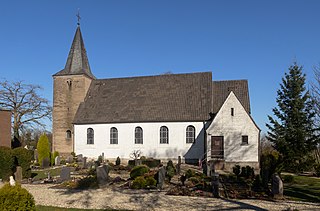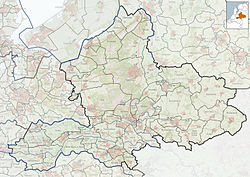
Nijmegen is the largest city in the Dutch province of Gelderland and the tenth largest of the Netherlands as a whole. Located on the Waal River close to the German border, Nijmegen is the oldest city in the Netherlands and the first to be recognized as such in Roman times. In 2005, it celebrated 2,000 years of existence.

Arnhem is a city and municipality situated in the eastern part of the Netherlands. It is the capital of the province of Gelderland, located on both banks of the rivers Nederrijn and Sint-Jansbeek, which was the source of the city's development. Arnhem had a population of 163,972 on 1 December 2021, which made it one of the larger cities of the Netherlands. The municipality is part of the Arnhem–Nijmegen metropolitan area, which has a combined number of 774,506 inhabitants on 31 January 2022.

Gelderland, also known as Guelders in English, is a province of the Netherlands, occupying the centre-east of the country. With a total area of 5,136 km2 (1,983 sq mi) of which 173 km2 (67 sq mi) is water, it is the largest province of the Netherlands by land area, and second by total area. Gelderland shares borders with six other provinces and the German state of North Rhine-Westphalia.

Groesbeek is a town and former municipality in the province of Gelderland, the Netherlands. In January 2015 the former municipality merged with Millingen aan de Rijn and Ubbergen. The larger area was known as Groesbeek until January 2016, when its name was changed to Berg en Dal.

Markelo is a village in the Dutch province of Overijssel. It is located in the municipality of Hof van Twente, about 20 km (12 mi) west of Hengelo and 20 km (12 mi) south-west of Almelo.

The Arnhem–Nijmegen metropolitan area is a former Dutch plusregio, public body and intermunicipal institution, founded in 1988, for the co-operation in the areas of housing, transport and economics in the conurbation consisting of the Dutch cities of Nijmegen and Arnhem as well as the bordering municipalities of Berg en Dal, Beuningen, Doesburg, Duiven, Heumen, Lingewaard, Montferland, Mook en Middelaar, Overbetuwe, Renkum, Rheden, Rijnwaarden, Rozendaal, Westervoort, Wijchen, and Zevenaar. All except Mook en Middelaar (Limburg) are in the province of Gelderland. Its aim is regional cooperation. In 2022, a total of 774,506 people were living in the municipalities (1,000 km2).

Beek is a village in the Dutch province of Gelderland. It is located in the municipality of Berg en Dal, about 5 km east of Nijmegen. It was sometimes referred to as "Beek " or "Beek-Ubbergen" because there are many villages called Beek.

De Horst is a village in the Dutch province of Gelderland. It is located in the municipality of Berg en Dal, about 2 km east of Groesbeek.

Wyler is a village along the Dutch-German border, 7 km southeast of Nijmegen, Gelderland, The Netherlands, and 5 km west of Kranenburg, Germany.

Duivelsberg is a hill and nature reserve in the municipality of Berg en Dal in the Dutch province of Gelderland, near the border with Germany. It is politically significant, however, because Duivelsberg is the only part of the Netherlands that was both annexed from Germany and retained after World War II.

Heilig Landstichting is a village in the eastern Netherlands. It is located in the municipality of Berg en Dal, Gelderland, near Nijmegen. Its best known attraction is the Museumpark Orientalis, the former Holy Land Museum.

Kekerdom is a village in the municipality of Berg en Dal in the province of Gelderland, the Netherlands. Kekerdom has 550 inhabitants (2008).

Ooij is a village in the eastern Netherlands. It is located in the municipality of Berg en Dal, Gelderland.

Persingen is a village situated in the municipality of Berg en Dal in the province of Gelderland. In 2021, Persingen had 105 inhabitants. The village claims to be the smallest village of the Netherlands for tourist reasons, however there are many more contestants who are much smaller; the former island of Schokland and the former squatter village of Ruigoord have the best credentials.

Berg en Dal is a municipality in the eastern Netherlands, in the province of Gelderland. It was formed through a merger of the municipalities of Groesbeek, Millingen aan de Rijn and Ubbergen in 2015. The resulting larger municipality maintained the name of Groesbeek until 2016, when it was renamed to Berg en Dal after the village of Berg en Dal.

The Africa Museum is a museum in Berg en Dal in the Netherlands. The museum on the outskirts of the city of Nijmegen is a complex with indoor as well as open-air display areas, covering art, culture, music, photographs, videos and architecture of Africa. As of 2014, the museum, along with the Tropenmuseum in Amsterdam, and National Museum of Ethnology in Leiden, together make up the National Museum of World Cultures.

Breedeweg is a village in the Dutch province of Gelderland. It is located in the municipality of Berg en Dal, about 1 km south of Groesbeek.

The Dutch: Nationaal Museum van Wereldculturen (NMVW) is an overarching museum organisation for the management of several ethnographic museums in the Netherlands, founded in 2014. It consists of the Tropenmuseum in Amsterdam, the Afrika Museum in Berg en Dal, and the Museum Volkenkunde in Leiden. The National Museum of World Cultures works in close cooperation with the Wereldmuseum in Rotterdam. It is also part of nation-wide Dutch organisations for research into provenance studies and projects of restitution of cultural heritage to countries of origin, like the former Dutch colony in today's Indonesia.

Berg en Dal is a village in the resort of Klaaskreek in the Brokopondo District of Suriname. The village is located on the Suriname River.

The Rijk van Nijmegen is a region in the southeast of Gelderland. The region is located around the city of Nijmegen, south of the Waal and east of the Land van Maas en Waal.


























